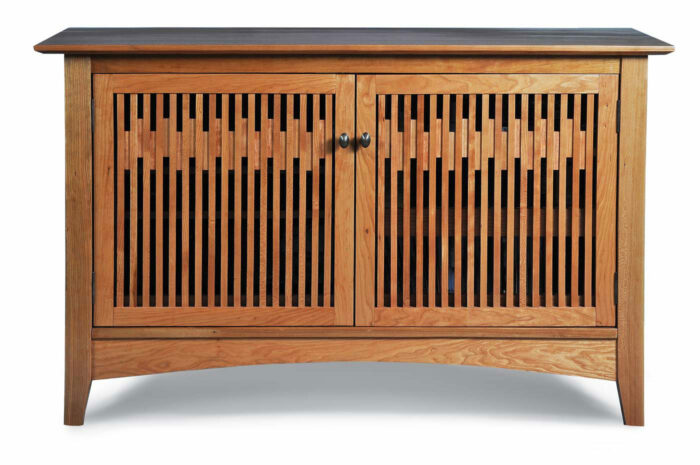
Synopsis: Robert Webb needed to house stereo and TV components, and so he decided to build a Craftsman-style cabinet. To allow sound and heat to escape—and remote-control signals to enter—he designed the doors with vertical spindles rather than solid panels. Instead of chopping lots of mortises into the rails, he cut grooves in the rails and inserted notched strips into them-creating mortises without mortising. In this article, he provides detailed instructions on the entire process, including adding decorative filler blocks.
I recently built a Craftsman-style console to house stereo and TV components, and I wanted the cabinet to be both beautiful and functional. To allow sound and heat to escape—and remote-control signals to enter—I traded solid door panels for vertical spindles common to the Craftsman style. To add visual interest, I inserted filler blocks between the spindles in a wavelike pattern.
This door design is especially helpful wherever ventilation makes sense—for a stereo cabinet like mine, or for kitchen cabinets, a bathroom vanity, a mudroom cabinet, a wine rack, or a closet. But it has a modern, minimalist style that will work in lots of places.
You can vary the size and spacing of the spindles, and there are a number of design possibilities for the filler blocks. While Craftsman-style furniture is traditionally made with quartersawn white oak, this contemporary take looks good in lots of woods. I went with cherry.
These doors are also fun to build, and they offer a number of valuable woodworking lessons.
Brief tour of the construction
 The door frames are reinforced with deep mortise-and-tenon joinery, ensuring they will stay square and swing freely for decades to come.
The door frames are reinforced with deep mortise-and-tenon joinery, ensuring they will stay square and swing freely for decades to come.
You can cut the joints however you like. I cut the mortises using the simple router box described in Bob Van Dyke’s article in FWW #303 (“Quick and Accurate Mortises”), with the help of a plunge router and a spiral upcutting bit. I formed the tenons on the table saw using a stacked dado set.
 The spindles are where things get interesting. I’ve learned in the past that you don’t want to mortise their full thickness into the rails. If you do, you’ll inevitably have small gaps, either right away or in the future, and viewers will be able to see down into those. The gaps will also trap dust. Instead, you want to cut short tenons slightly smaller than the spindles. The small tenon shoulders will hide the joints.
The spindles are where things get interesting. I’ve learned in the past that you don’t want to mortise their full thickness into the rails. If you do, you’ll inevitably have small gaps, either right away or in the future, and viewers will be able to see down into those. The gaps will also trap dust. Instead, you want to cut short tenons slightly smaller than the spindles. The small tenon shoulders will hide the joints.
Chopping dozens of equally spaced mortises in the rails would be tedious to say the least. My approach does away with mortising altogether. Instead, I cut grooves in the rails and insert notched strips into them—forming mortises without actually mortising. This approach is not only straightforward but also versatile, and it can be used for vertical or horizontal spindles of any size.
As for the decorative filler blocks, those are glued into place after the door frames and spindles are assembled.
| From Fine Woodworking #315
To view the entire article, please click the View PDF button below. |
 |
Fine Woodworking Recommended Products

Veritas Precision Square
This precision square is incredibly versatile, from checking squareness to dialing in machine setups.

Veritas Standard Wheel Marking Gauge
A wheel-type gauge is the easiest to use, and this wonderful Veritas model is a steal at $38.

Leigh Super 18 Jig
This jig is a value-oriented alternative to the Leigh D4R, but its template system is just as excellent.
Sign up for eletters today and get the latest techniques and how-to from Fine Woodworking, plus special offers.
Download FREE PDF
when you enter your email address below.

